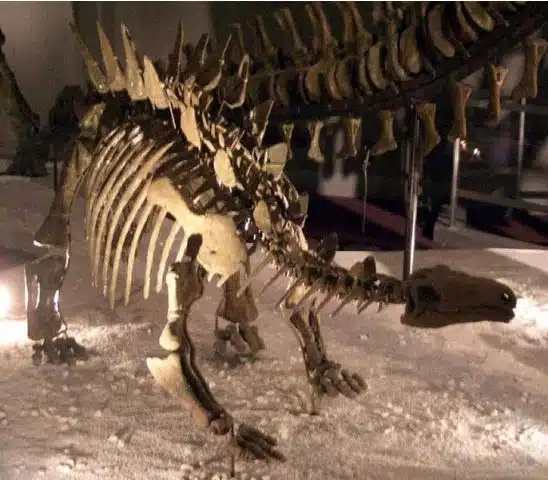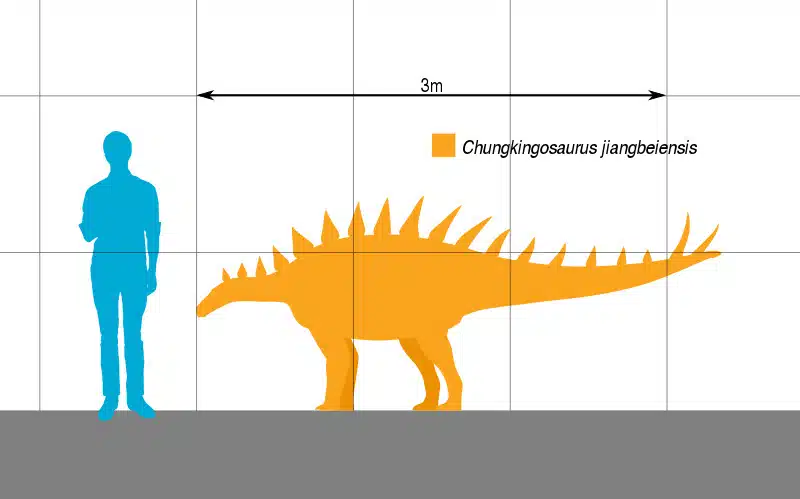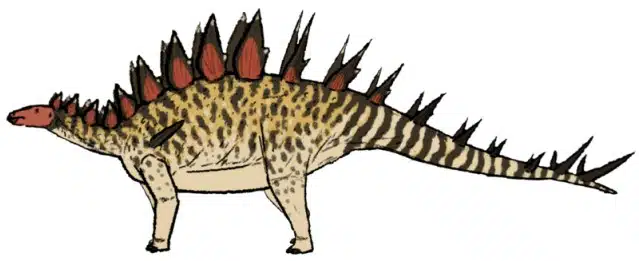Long ago, this world was ruled by dinosaurs of all shapes and sizes as they adapted and survived to environments vastly different to the ones we now know. Among these ancient beings was a unique dinosaur, Chungkingosaurus–an herbivore that roamed present-day China. This dinosaur, with its distinctive features and intriguing history, offers us a glimpse into this world long past.
Chungkingosaurus, like many of its stegosaurid relatives, can be recognized by its impressive defensive display of plates and spikes along its back and tail. Even though it was one of the smallest stegosaurids, it was no less capable. Come with us as we discover what other features make this dinosaur unique in comparison to its contemporaries and relatives.
Chungkingosaurus Key Facts
| Keyword | Fact |
|---|---|
| Chungkingosaurus pronunciation | chung-ching-oh-saw-ruhs |
| Meaning of name | Chongqing lizard |
| Group | Stegosauria |
| Type Species | Chungkingosaurus jiangbeiensis |
| Diet | Herbivore |
| When it Lived | 168.3 to 163.5 MYA |
| Period | Late Jurassic |
| Epoch | Bathonian to Callovian |
| Length | 10-12 ft |
| Height | 3-4 ft |
| Weight | 1.5 tons |
| Mobility | Moved on four legs |
| First Discovery | 1977 by Chinese pale. Dong Zhiming, Zhou Shiwu and Zhang Yihong |
| Location of first find | Chongqing, China |
| First Described by | 1983 by Chinese pale. Dong Zhiming, Zhou Shiwu and Zhang Yihong |
| Holotype | CV 00206 |
Chungkingosaurus Taxonomy and Timeline

Chungkingosaurus got its name from the Chinese city of Chongqing and the Greek word “sauros” for lizard. This dinosaur is a fascinating creature that offers us a window into the past.
In terms of taxonomy, Chungkingosaurus belongs to the Stegosauria group–a family of herbivorous dinosaurs known for their distinctive rows of bony plates and spikes along their backs. Specifically, it is a member of the Stegosauridae family and its type species is Chungkingosaurus jiangbeiensis.
The timeline of this dinosaur is set in the Late Jurassic period, specifically between the Bathonian to Callovian epochs. This places the dinosaur’s existence over a hundred million years ago in a time when the earth was a vastly different place than it is today.
Discovery & Fossil Evidence
The story of its discovery begins in 1977 in the city of Chongqing, China. The first fossils of this dinosaur were unearthed here, marking the beginning of a new chapter in the field of paleontology. The discovery was made by a team of Chinese paleontologists, Dong Zhiming, Zhou Shiwu, and Zhang Yihong, who would go on to describe the dinosaur in 1983.

It has also been found in other locations within China–specifically four additional sites within the country. These discoveries have added to our understanding of this dinosaur and its place in history. The fossils found include a variety of specimens, from partial skeletons to individual bones. These fossils provide a wealth of information about Chungkingosaurus, allowing scientists to piece together its physical characteristics and lifestyle. The degree of preservation of these fossils varies, but each find contributes to the overall picture of this fascinating dinosaur.
Chungkingosaurus Size and Description
It was part of a group of herbivorous dinosaurs known for their distinctive rows of bony plates and spikes along their backs. This was one of the smallest of these stegosaurs, with an estimated length of less than four meters. It had a deep snout and front lower jaws, resulting in a high and narrow skull. Its teeth were non-overlapping and had less pronounced denticles.
Chungkingosaurus is believed to have had two rows of plates and spikes on its back, arranged in pairs. The exact number of these plates and spikes is unknown, but a model in the Chongqing Municipal museum shows fourteen pairs of plates and two pairs of tail spikes. The plates of Chungkingosaurus had a thickened middle section, suggesting they were modified spikes.
Size and Weight of Type Species

Chungkingosaurus was a relatively small dinosaur, especially when compared to some of its contemporaries. The holotype of Chungkingosaurus jiangbeiensis, the type species, was one of the smallest stegosaurs with an estimated length under 12 feet.
As for the weight of Chungkingosaurus, given its size and the general body structure of stegosaurs, has been estimated at around 3000 lbs. This makes Chungkingosaurus a relatively lightweight dinosaur–especially when compared to the massive sauropods of its time.
The Dinosaur in Detail
Along with its small size, this was a dinosaur with a host of unique features. These features not only set it apart from others of its time but also provided it with the tools it needed to survive in its environment.
One of its most distinctive features was its plates and spikes. These structures ran along the dinosaur’s back and tail and were likely used for defense against predators. The plates had a thickened middle section, suggesting they were modified spikes. This is a unique feature among stegosaurs, and it speaks to Chungkingosaurus’s adaptability and survival instincts.
Another notable feature of Chungkingosaurus was its skull. The dinosaur had a high and narrow skull with a deep snout and front lower jaws. This skull shape, combined with its non-overlapping teeth, suggests that this herbivorous dinosaur had a specialized diet that further highlights its adaptability.
The Chungkingosaurus in its Natural Habitat

It lived during the Late Jurassic period during a time when the earth was a vastly different place than it is today. The environment it inhabited was likely lush and diverse with a variety of vegetation for this herbivore to feed on.
As an herbivore, this dinosaur would have primarily fed on plants. It is possible that it used its unique skull shape and dentition to feed on something like tougher vegetation. This dietary adaptation would have played a significant role in shaping the landscape around it, as it would have contributed to the control of plant growth and the spread of plant species.
It shared its habitat with other Asian dinosaurs, including other stegosaurs such as Chialingosaurus, Gigantspinosaurus, and Tuojiangosaurus. It also lived alongside larger sauropod dinosaurs such as Mamenchisaurus, and may have had to defend itself against predatory dinosaurs such as Sinraptor, Leshansaurus, and Yangchuanosaurus. This suggests that Chungkingosaurus was part of a complex ecosystem, with a variety of interactions between different species.
Interesting Points about Chungkingosaurus
- It was one of the smallest stegosaurs with an estimated length four-to-five meters.
- Along with its small size, it had a high and narrow skull and unique dentition that set it apart from other stegosaurs.
- The defensive plates were arranged in pairs rather than in an alternating pattern–a feature that is unique among stegosaurs.
- This dinosaur also had a thagomizer at the end of its tail composed of two pairs of spikes that pointed out to the sides. It would have used this structure to fend off predators and perhaps intimidate competition.
Contemporary Dinosaurs
Chungkingosaurus shared its world with great number of contemporaries. These fellow Asian dinosaurs, each unique in their own right, played a part in the intricate dance of existence, their lives intertwined in a complex web of survival and competition.
Tuojiangosaurus was a fellow stegosaurid that roamed the same regions as Chungkingosaurus. Though similar in many ways, Tuojiangosaurus was larger. Indeed, its size was perhaps a testament to a different approach to survival. Even so, despite their size difference, these two dinosaurs likely shared a similar diet. They both grazed on the low-lying vegetation of their shared environment.
Gigantospinosaurus, another contemporary stegosaurid, presents a stark contrast. Its enormous shoulder spines might have served as a deterrent for predators. Indeed this is a function that Chungkingosaurus‘ own thagomizers might have also served. Much like Tuojiangosaurus, Gigantospinosaurus was considerably larger. The coexistence of these three relatives paints a picture of a diverse world.
Yangchuanosaurus and Mamenchisaurus, both larger than Chungkingosaurus, represent different aspects of the ecosystem. The giant sauropod Mamenchisaurus, with its long neck reaching for the treetops, likely existed in a different feeding niche. Its presence would have served as a reminder of the diverse forms of life that Chungkingosaurus shared its world with. Yangchuanosaurus, on the other hand, was a predator that might have posed a threat to Chungkingosaurus. Adding a layer of tension to their coexistence one could say, seeing as it possibly saw Chungkingosaurus as prey. Together, these contemporaries weave a complex story of life and survival in the prehistoric world, with Chungkingosaurus at its center.
List of All Dinosaurs
We have created a list of all dinosaurs we have covered here, sorted across the seven main groups of dinosaurs. We also include information about their type of diet, (omnivore, herbivore or carnivore) and the time they lived.
Frequently Asked Questions
The name translates to “Chongqing lizard”. This is a nod to the city of Chongqing in China where the first fossils of this dinosaur were discovered.
It lived during the Late Jurassic period, specifically between the Bathonian to Callovian epochs. This places the dinosaur’s existence around 168.3 to 163.5 million years ago.
As an herbivore, it would have primarily fed on plants. Furthermore, its high and narrow skull and non-overlapping teeth suggest that it had a specialized diet, possibly consisting of tougher vegetation.
This dinosaur was a quadruped, meaning it moved on all four legs.
This was one of the smallest stegosaurs. It is estimated to have been around four feet long, though possibly reached lengths of five feet.
Sources
- https://www.researchgate.net/publication/265082916_Dinosaur_assemblages_from_the_Middle_Jurassic_Shaximiao_Formation_and_Chuanjie_Formation_in_the_Sichuan-Yunnan_Basin_China
- https://onlinelibrary.wiley.com/doi/abs/10.1111/1755-6724.13535
- https://www.researchgate.net/publication/230854867_A_review_of_Late_Jurassic_stegosaurs_Dinosauria_Stegosauria_from_the_People’s_Republic_of_China
Article last fact checked:Joey Arboleda, 06-11-2023
Featured Image Credit: National History Museum
